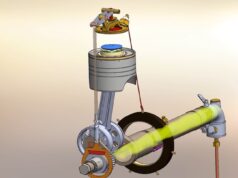A hydraulic ram, or hydram, is a cyclic water pump powered by hydropower. It takes in water at one “hydraulic head” pressure and flow rate, and outputs water at a higher hydraulic head and lower flow rate. The device uses the water hammer effect to develop pressure that allows a portion of the input water that powers the pump to be lifted to a point higher than where the water originally started.
source/image: Practical Engineering
The waste valve is open because of its own weight, and the delivery valve is closed under the pressure caused by the water column from the outlet. The water in the inlet pipe starts to flow under the force of gravity and picks up speed and kinetic energy until the increasing drag force lifts the waste valve’s weight and closes it.
The momentum of the water flow in the inlet pipe against the now closed waste valve causes a water hammer that raises the pressure in the pump beyond the pressure caused by the water column pressing down from the outlet.A hydraulic ram is a clever device invented over 200 years ago that can pump water uphill with no other external source of power except for the water flowing into it and there is a way to take advantage of this normally inauspicious effect for a beneficial use.
Advertisement
The ram pump is an ingenious way to take advantage of the properties of fluids. We all need water for a variety of reasons, so being able to move it where we need it without any fancy equipment or external sources of power is a pretty nice tool to have in your toolbox.











